ENVIRONMENTAL PROTECTION COMMITTEE MINUTES - SEPTEMBER 10, 2018
MICHAEL E. PLOCHOCKI, CHAIRMAN
MEMBERS PRESENT: Dr. Chase, Ms. Cody, Mr. Burtis
MEMBERS ABSENT: Mrs. Tassone
ALSO ATTENDING: See attached list
Chairman Plochocki called the meeting to order at 9:09 a.m. A motion was made by Dr. Chase, seconded by Ms. Cody, to waive the reading of the proceedings from the previous committee. MOTION CARRIED. A motion was made by Dr. Chase, seconded by Mr. Burtis, to approve the minutes of the previous committee meeting. MOTION CARRIED.
1. WATER ENVIRONMENT PROTECTION: Tom Rhoads, P.E., Commissioner
a. A Resolution Approving Proposed Improvements for the Onondaga County Sanitary District Consisting of the Removal of Extraneous Flows from the Meadowbrook-Limestone Wastewater Treatment Plant in and for the County of Onondaga, New York ($9,000,000)
Chairman Plochocki stated these items were discussed last month.
Mr. Rhoads presented items 1a and 1b simultaneously:
-
Special District, recent approval sponsored a public hearing, now seeking approval for the project and bonds, two separate resolutions
-
GHD completed their engineering report – provides big-picture updated information on the costs and where work will be performed, includes contingency, engineering, and administrative costs
Table 6.1 Estimated Construction Costs and Estimated Total Project Costs for
the MBLS WWTP Service Area I/I Removal Projects
Municipality - Owner |
Estimated Manhole Inflow Projects
(2018 dollars) |
Estimated Cleanout Cap and Catch Basin Inflow Projects
(2018 dollars) |
Estimated Infiltration Rehabilitation Projects
(2018 dollars) |
Estimated Construction Cost
(2018 dollars) |
Estimated Total Project Cost (1)
(2018 dollars) |
City of Syracuse |
$118,000 |
$1,090,000 |
$2,700,000 |
$3,908,000 |
$5,300,000 |
Town of Dewitt |
$67,000 |
$2,000 |
$150,000 |
$219,000 |
$300,000 |
Town of Manlius |
$311,000 |
$55,000 |
$583,000 |
$949,000 |
$1,300,000 |
Village of Fayetteville |
$93,000 |
$10,000 |
$636,000 |
$739,000 |
$1,000,000 |
Village of Manlius |
$64,000 |
$65,000 |
$538,000 |
$667,000 |
$1,000,000 |
Onondaga County |
$70,000 |
$0 |
$0 |
$70,000 |
$100,000 |
Sum |
$723,000 |
$1,222,000 |
$4,607,000 |
$6,522,000 |
$9,000,000 |
(1) The total Project Cost reflects Construction Cost plus 15% contingency plus 20%
engineering/ administration/financing (and rounding to nearest $100,000).
GHD | Meadowbrook-Limestone Service Area Inflow & Infiltration Evaluation and Facility Plan | 11151834.1 | Page 21
b. BOND RESOLUTION: A Resolution Authorizing the Issuance of $9,000,000 Bonds of the County of Onondaga, New York, to Pay Costs of Improvements for the Onondaga County Sanitary District Consisting of the Removal of Extraneous Flows from the Meadowbrook-Limestone Wastewater Treatment Plant ($9,000,000)
-
Application submitted Friday afternoon, all 5 municipalities sponsored resolutions to enter into an IMA with us – no small thing for a period fewer than 40 days
-
County looking forward to participating, leadership discussing county contribution for the project, don’t have specifics; grant typically awarded in November, have until then to get to the fine details on reimbursement and county contribution
-
All municipal attorneys in the service area were served a thorny letter from the DEC, highlights the importance….
Chairman Plochocki interjected and asked to be provided with a copy of the letter. Mr. Rhoads stated he would email a copy. Chairman Plochocki apologized for interrupting.
-
Wish everything was all roped and tied, hopes all understand it takes more time - never the less asking for $9 million in bonds for improvements to help abate extraneous flows in the Meadowbrook-Limestone area, which is overwhelming our treatment plant
Chairman Plochocki stated he wanted to compliment Mr. Rhoads and WEP for the record, “Even though, as you just pointed out, this is an unusual situation where all the i’s aren’t dotted and t’s crossed. Of course, we would all, you included, prefer that not be the situation, the fact is we would rather be in this situation if it means we have the opportunity to get more money. We want you guys keeping your eyes on the grant and if we waited to do everything in our normal course of business, but we missed this grant, it would have been much more disappointing. So thank you for keeping your eye on the prize and this is what we want. If we have things that need to be expedited a bit, in order to have a good shot at the money, we want to go ahead and do it. So please keep up the good work with us.” Mr. Rhoads replied, thank you.
Mr. Burtis asked for more explanation on the manhole inflow projects in the Town of Manlius and the infiltration and rehabilitation projects in the City of Syracuse. Mr. Rhoads responded that the manhole costs were identified based on GHD’s work. Over time the manhole work has become more expensive but the sewer lining work has become less costly as technologies have improved. That changed some of the equations, putting a little more burden on the Town of Manlius manholes. These are big picture; the grant includes work for engineering - will use night lamping to determine which manholes will be repaired. A lot of infrastructure televising has been done in the City. Broken pipes and root intrusion is driving some of these costs. Also, the County is doing its Meadowbrook-Limestone trunk sewer in the City portion of the sewershed and has disconnected 22 stormwater catch basins. We hope to have a significant contribution associated with these infiltration issues. In answer to Mr. Burtis, Mr. Rhoads confirmed that the linings were part of the infiltration. Mr. Burtis asked if they were also part of the construction cost. Mr. Rhoads responded that the table, in theory, adds up the estimated construction costs. The contingency item brings the project from $4 million to $5.3 million. The math eludes him at times so he provided the table directly from the report; much of this is in the fine print and footnotes.
Chairman Plochocki asked the name of the GHD contact. Mr. Rhoads responded that John LaGorga is the engineer and Bruce Munn is the principal. Chairman Plochocki stated that we have worked with them before and they are a great group. To be abundantly clear the totals in the far right column have not been officially agreed to. They are good faith targets and we hope our partners will see the reasoning behind this. Mr. Rhoads agreed.
Chairman Plochocki asked if we would then bond for less assuming the municipalities provide the funds listed. Mr. Rhoads responded that the resolution sets a project not to exceed value, which is a maximum estimated cost of $9 million. This resolution does not specifically state amounts for each municipality, although he would anticipate each municipality will want a not to exceed value. Dr. Chase asked how municipalities would pay this back. Mr. Rhoads responded that he assumes they would pay this back over a 20 year period. The leadership of the executive and legislature is also looking at how the County should perhaps contribute to sweeten the pot. The County invested about $1.6 million in this sewershed with suburban I&I projects added to the 2018 budget. Also, the UV clarifier project is coming in under budget so there will be some funds available. There are some things to talk about but he is not in a position to give anything specific.
Mr. Burtis said that the extraneous flow numbers are known and asked if we would be able to run the numbers, to get a better feel, after completing the projects. Mr. Rhoads responded that the numbers have changed since the 2002 report where they hoped to be able to pry out 1.9 million gallons of extraneous flow on an average daily basis. GHD is saying that this project will harvest about 6.9 million gallons of peak I&I. There are times of the year when we don’t have appreciable I&I during dry months, typically August and September. In the spring we certainly have peaks and this will help shave those. We spend about $2 for every 1,000 gallons we pump, store and treat so if we reduce the amount of extraneous flow we will have some O&M savings. Mr. Burtis said that his only question was if we have the number and will be able to run the numbers again to see what we did. Mr. Rhoads responded that the numbers are in the report and we will be required to do the math. Extraneous flow is built around the groundwater table, rain conditions, and time of day conditions. All of this makes the precision of measuring difficult but over time we will build a history of data to demonstrate what this is. This is a build and measure project that will take about 5 years to build and execute. All capital project funds are borrowed incrementally as the money is spent; final borrowing could be 6 years from now.
A motion was made by Dr. Chase, seconded by Mr. Burtis, to approve item 1a. Passed unanimously; MOTION CARRIED.
A motion was made by Dr. Chase, second by Ms. Cody, to approve item 1b. Passed unanimously; MOTION CARRIED.
Chairman Plochocki asked for an update on the Clean Water Fair.
-
Held a good event, provides an opportunity for WEP to demonstrate the ethicacy of treatment and the Save the Rain program
-
Offered to provide a tour for the committee, will be proposing a couple projects at Metro as part of the capital projects, good for the committee to see what is going on, last toured about 5 years ago
A motion was made by Mr. Burtis, seconded by Ms. Cody, to adjourn. MOTION CARRIED.
The meeting adjourned at 9:32 a.m.
Respectfully submitted,

KATHERINE M. FRENCH, Deputy Clerk
Onondaga County Legislature
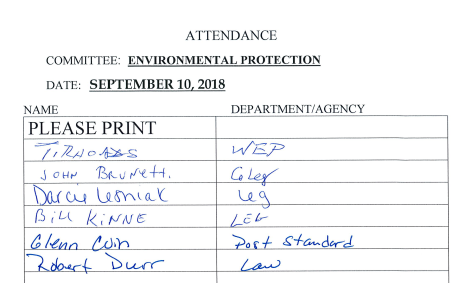
* * *
PUBLIC SAFETY COMMITTEE MINUTES – SEPTEMBER 10, 2018
AT HILLBROOK DETENTION CENTER, 4949 VELASKO ROAD, SYRACUSE
CHRISTOPHER J. RYAN, CHAIRMAN
MEMBERS PRESENT: Mr. McBride, Mr. Bush, Mr. Jordan
MEMBERS ABSENT: Mr. Rowley
ALSO ATTENDING: Mr. Knapp, Dr. Chase, Mrs. Ervin; see attached list
Chairman Ryan called the meeting to order at 12:03 p.m. A motion was made by Mr. Jordan, seconded by Mr. Bush to waive the reading of the minutes of the previous committee meeting; MOTION CARRIED. A motion was made by Mr. Jordan, seconded by Mr. McBride to approve the minutes of the previous committee meeting; MOTION CARRIED.
1. SHERIFF: Sheriff Eugene Conway
a. Informational Update
- Accreditation – set of standards varying depending on level of accreditation that must be adhered to; lasts 3 - 5 years
-
Required to maintain those standards – showing maintaining standards via self-audit, and outside auditors coming in
-
Police side of Sheriffs accredited for many years; every 3 yrs auditors come in to tour facility, speak to department, see maintaining standards; last week traveled to Albany to receive accreditation from Sept. 2018 – Sept. 2023
-
Sheriff accredited from state for Justice Center; higher level through American Correctional Association - 6 out of 200 jails in NYS achieve this level; NYS accreditation is ~130 standards; national level almost 400 standards
-
End of April, auditors spent 3 days going through Justice Center talking to staff, inmates, contract medical personnel
-
Report showed compliant on 98% of standards; 2% - physically cannot enlarge individual cells (exception)
- Result of many people over months of time; Justice Center employees strived over 3 months to ensure success
Chairman Ryan thanked Sheriff Conway for his time, said congratulations, and asked if this includes the correctional facility. Sheriff Conway said they are eligible for ACA accreditation, and is confident that within the next calendar year Jamesville will receive the same level of accreditation.
Mr. Jordan asked for examples of the different criteria for accreditation that the Sheriff needs to comply with. Sheriff Conway responded it is in the binder he has. Everyone who has a role in the Justice Center (including medical staff and contracted food service) plays a part in maintaining the standards 24 hours a day. The binder gives an idea of the almost 400 standards to meet.
Mr. McBride asked if the report is available for anyone to see. Sheriff Conway replied yes. It is a public document, and Sheriff Conway will see if it can be added to their website. Copies can be made available to anyone. Mr. McBride asked if he knew the outcome of the auditor’s findings before they left. Sheriff Conway answered that at the end of the third day there was an exit interview where the auditors reported their findings, and what they were going to report back to the Association. Their recommendations are what the association listens to. The conference in Minneapolis in August is when the department received the award.
Chairman Ryan requested a hard copy of the binder, and Mr. Jordan would like to receive via email. Sheriff Conway said absolutely.
Chairman Ryan asked about the population trends, and Sheriff Conway explained that they receive a report from the state every month with that information. Over the last two years, the population is trending downward. With Jamesville under the Sheriff, the Sheriff’s department has the ability to manage bed space.
Mr. Knapp asked how centralized booking is going. Sheriff Conway responded:
- Going well operationally; good concept; concerns with Sheriff’s staffing of deputies transporting
-
Centralized arraignment court in place, but other municipal justice courts still have court; obligated to transport inmates to all different courts day and night; commitment of 5 deputies every day for 365 days a year
-
Transport deputies work 5 days a week; being done on an overtime basis (since Sheriff Conway started)
-
Good budget projection numbers for end of year; but need for more staff for transporting due to centralized arraignment
-
Other concern is reimbursement; this was not in the budget, but they have to perform the duty
2. HILLBROOK: Ann Rooney, Deputy County Executive; Damian Pratt, Director of Juvenile Justice
a. Raise the Age Presentation
Ms. Rooney:
-
Hillbrook will have licenses for 2 facilities Oct. 1st - why operational strategies and ratio of employees had to change
-
Raise the Age (RTA) – permitting 16 year olds Oct. 1st and 17 year olds next Oct. 1st to be at Hillbrook
-
Licenses through NYS Office of Children and Family Services (OCFS) as well as Commission on Corrections
-
Working with Facilities; by Oct 1st need adjustments to the cafeteria, clips for panels in ceiling to prevent people from getting up into drop ceiling, and a separate admissions area on north side of building for 16 year olds
-
Next summer anticipate expansion of 2 wings, and large expansion of admissions area – want young people to be acclimated within first 10 days here (often times they are not here past 10 days, and will not move to regular population)
-
Plan submitted to state last Tuesday; next is State Office of Budget; only 1 of 10 counties submitted a plan
Chairman Ryan asked if there was a deadline for submitting the plan. Mr. Pratt responded:
-
Every county required to submit budget template provided by state; every county required to submit RTA plan, if they were seeking 100% reimbursement
-
Plans due on or after April 4th, but budget template not submitted by state until May; first come, first serve basis
-
Prior to submitting plan, capital improvement project (~$400,000) submitted and approved for 100% reimbursement
Mr. Pratt said he is grateful for everyone attending the meeting, and he is extremely proud of the work being done at Hillbrook by the dedicated staff.
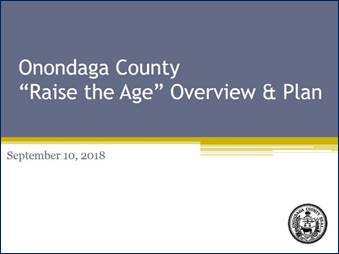 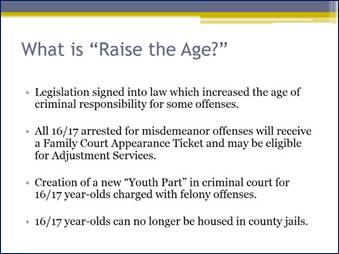
- Appreciate Sheriff’s Department for their staff helping Hillbrook get to accreditation; working to go above and beyond standards set by OCFS
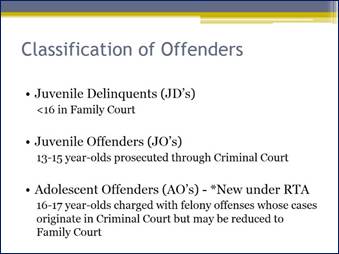 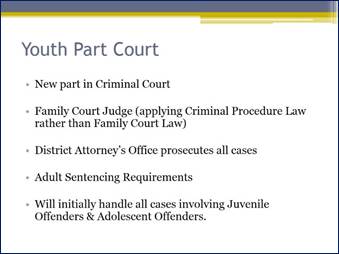
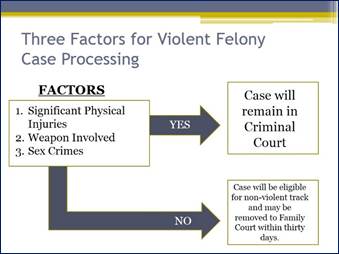 
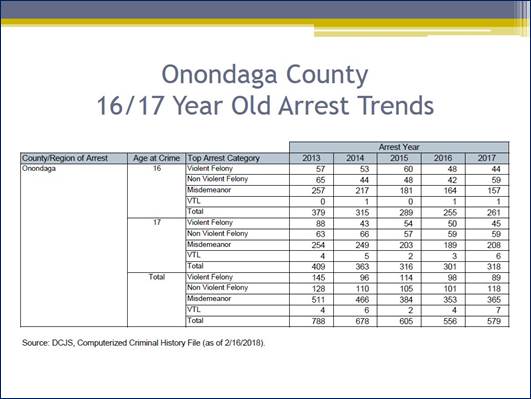
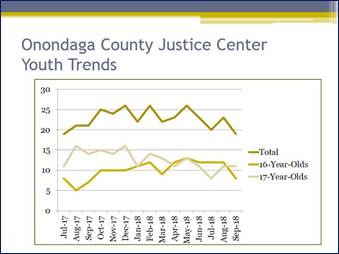 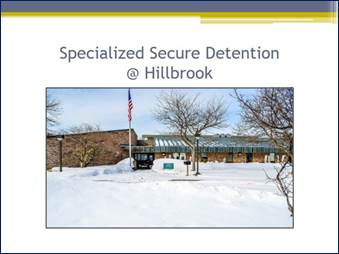
- There will not be a mass migration of young people to Hillbrook on Oct. 1st; young people currently in criminal court will continue cases through criminal court
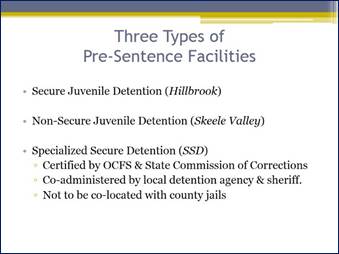
- Non-secure detention – 10 yrs ago contracted 18 beds; today its 1 bed/day annually, because of Juvenile Justice reform
- With RTA, looking to expand contract for non-secure detention beds
- SSD will need to exist in next 3 weeks
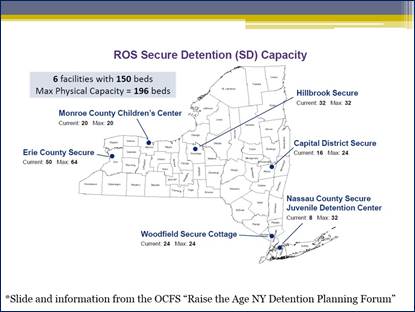
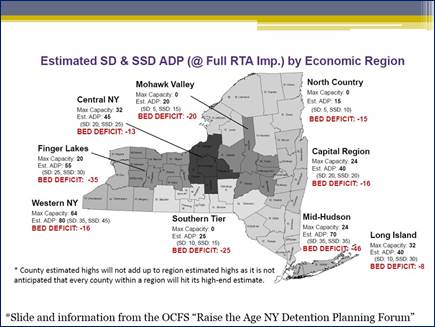
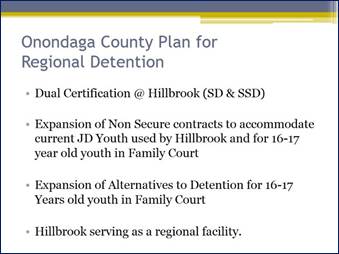 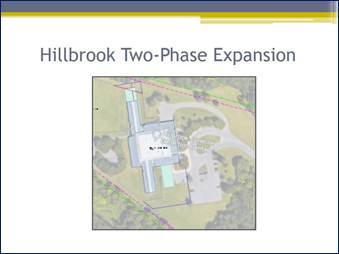
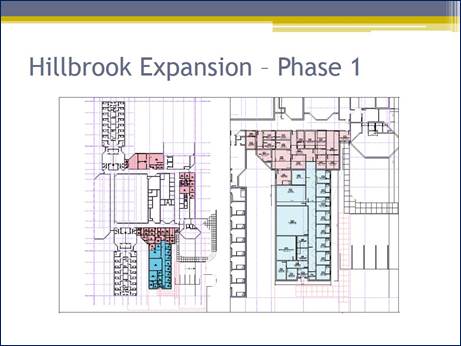
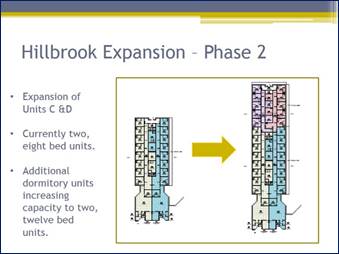 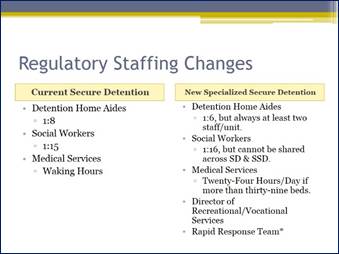
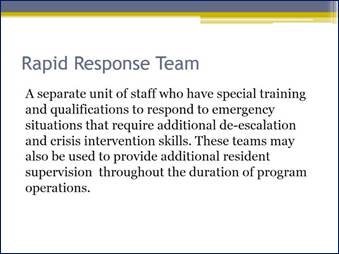 
-
Rapid response team – 2 roles; (1) safety and security including daily and weekly security checks; (2) team to provide front level engagement to reduce critical incidents
-
Rapid response team is new and only required during waking hours (2 waking shifts); 3 individuals per shift with 6 new positions – current staff being promoted to these positions
-
Budget template – 5 sections, but 3 applied to oversight from OCFS; costs reviewed with state on Friday, and state felt it was fiscally responsible
Chairman Ryan thanked Mr. Pratt and Ms. Rooney.
Mr. Pratt replied to Mr. Bush that the understanding is that this is 100% reimbursable. Mr. Bush asked if there is adequate training of the employees at Hillbrook to deal with the population. Mr. Pratt answered:
-
Requirements for positions well exceed what’s required for state; state regulation for entry level frontline staff is high school diploma; County requires high school diploma and work experience with young people
-
Degrees required by regulation for certain positions in education and social work
-
Qualifications exceed minimum standard; also use Behavior Management System - Therapeutic Crisis Intervention (TCI) developed at Cornell University; all new staff receives several weeks of training in this
-
Frontline staff - education setting cannot prepare working in a facility like this; best training is on the job Therapeutic Crisis Intervention training; prepares staff for difficult crisis that might occur
-
Spend time with staff; reintroduce every 6 months; used for years in minimizing injuries; TCI training important
-
Entry level positions are not Civil Service including Detention Home Aides and Home Aide 2s
-
Anything higher than that (i.e. managers) are Civil Service tested
Mr. McBride asked if TCI training is done after someone is hired, and Mr. Pratt replied yes. Mr. McBride asked if there is a time before a person is working within the population, and how is it managed. Mr. Pratt responded:
-
New employees have onboarding and training process; they go through classroom training, practice skills, learn how to do life space interviews; all embedded in TCI; then rigorous shadowing process for 6-8 weeks with current staff
-
They are not assigned a unit of young people for 2 months
-
New regulations and staffing ratio say no fewer than 2 staff per unit; always others there to help with support
-
Ratios do not take into consideration the education program (4 teachers on staff), several child care workers in educational roles, recreational staff or vocational staff; ratios speak to minimal staff to help run a unit
Mr. Bush asked how they recruit new staff. Mr. Pratt replied that they post job listings on Indeed.com, Personnel does recruiting, and some word of mouth. Ms. Rooney added in youth work (i.e. Boys and Girls Club) there is great word of mouth about Hillbrook. Mr. Pratt stated there are internship opportunities through Lemoyne College and Syracuse University as well; some college graduates come in at an entry level position with an Associates or Bachelor’s degree. Six months work experience is only required with a high school diploma. Ms. Rooney said those with degrees are immediately qualified to take the civil service exam.
Chairman Ryan stated that everything being done at Hillbrook is to get the kids out of the system. A large component of this is education at Hillbrook. What assurances are there, and what is the plan to ensure a youth offender is getting the education, rehabilitation and social work programs they need? Mr. Pratt answered:
-
5.5 hour school day; above and beyond regulations; certified teachers teaching NYS curriculum; regents tests available
-
RTA – regulation to provide vocational or alternative for those that have achieved a high school diploma or equivalent; not seeing 17 year olds until next October, so on back burner currently; will address in early 2019
-
Parallel program and partnership with Syracuse Pit Crew and Second Chance Canine Program, who deliver educational opportunities
-
Oversight from NYS Dept. of Education – meet quarterly to make sure educational system up to standard of what youth would get if they were residing in community
Ms. Singletary asked if Hillbrook uses risk assessment tool used for detention admissions, and if it will apply to 16 year olds. Mr. Pratt replied:
-
Yes or no; state created state assessment tool (based on County’s) to attempt to predict young person’s risk of failing to appear for court appearance, or committing new offense
-
Currently when juvenile delinquent appears in court seeking afterhours admission, detention staff produce a detention risk assessment score
- If young person qualifies, then able to be admitted to facility
- If they do not, then they need to be released on an appearance ticket – unless 3 criteria: firearm, sex offense within a home, or arson
-
Statewide under RTA, a young person will never be admitted to detention facility without being seen by a judge or magistrate first
-
After October 1st, Detention Risk Assessment (DRA) can be provided to judge or magistrate to help inform decision
-
No direct admission by Police; only way to be admitted into Hillbrook is with a securing order or warrant
-
Challenge with DRA is that it was never validated for 16 yr old population; DRA heavily weighs prior PINS involvement, which in Onondaga County has almost been eliminated; only 1 PINS petition filed in court this year, and 1 last year
Chairman Ryan stated that Onondaga County is leaps and bounds ahead of the curve.
Ms. Gwinn asked what is happening with the girls, and for an elaboration on Skeele Valley. Mr. Pratt responded:
-
Female population has declined significantly; today 1 female resident (from another county); Justice Center averages one 16 or 17 year old/day; female population small
-
RTA – state predicting not enough beds to meet needs for all counties; one prevision was to allow female adolescent offenders, juvenile offenders and juvenile delinquents to be comingled within one housing unit
-
Provided significant pushback locally; felt the staff at Hillbrook should be able to determine classification of young people in the facility based on: age, maturity, physical size, cognitive functioning
-
Females will all be housed within 1 unit; currently an 8 bed unit for 1 young lady; not sure regionally what the specialized secure female population will be; better to take out of county females, so they are not isolating females from peers
-
Current female resident is in program during day with other male units (when safe and appropriate to do so); well within regulations; keeping smaller units of 2 or 3 young people
-
Plan is to keep all Onondaga County youth in the County
-
Another county asked about exchange program, but always remained firm on keeping Onondaga County youth here to be closer to family, counsel, and hopefully engaging with service providers
-
Skeele Valley located in Tully, NY; advantages to not having in Syracuse or suburb near Syracuse; majority of young people there have risk of AWOL or failure to appear in court
-
Do not know what expanding non-secure contracts will look like; good partnership with Skeele Valley and Elmcrest
-
Looking at immediate need of not having juvenile delinquents in Hillbrook when possible by increasing the contract with Skeele Valley; not to say they won’t look at other agencies; need to identify who will be the best partner
Mr. Jordan asked how they provide educational services, and how they handle students who are not really engaged, or being distracting. Mr. Pratt answered:
-
Have to find their motivation and hook; curriculum is interacting with teachers and Odysseyware software that Syracuse City Schools uses – can start lesson plan, and youth can pick up where they left off when back to their own school
-
Challenge with motivating kids is if the work they do in Hillbrook will count for something; issues when young people put in work, leave facility and school says they did not work towards credits; youth can earn credits while in Hillbrook
-
Behavioral point system – by meeting certain thresholds and criteria’s during the course of the day, they can earn things they want like food items, hygiene products or additional time for phone and family visits
-
Always have young people with problematic behaviors in the classroom, which is usually in first week; staff will find out why the behavior is happening, and correct it; young people then fall into the routine
-
Today’s committee is in a classroom – never more than 8 youth at a time in class; looking at possibly staggering school day, because they cannot have adolescent offenders comingling with juvenile delinquents and offenders
Mr. Knapp said:
-
(to answer previous questions) Judges had training for centralized booking this week
-
Not worried about bricks and mortar being reimbursed, but more with personnel side; personnel is forever, and every year it is subject to legislative review in Albany; can foresee a time when the state will reduce the percentage
-
Ace in the hole is being a regional facility taking in youth from other counties
-
Can the County’s equation vary based on the states reimbursement, so the County receives maximum reimbursement from other counties? How does that work?
Mr. Pratt responded that out of County youth are always 100% reimbursed by other counties. Mr. Knapp asked if the equation will change when there is more staffing. Ms. Rooney answered yes. Every year the daily rate is calculated, and all of the costs are included in the daily rate. The County will get 100% reimbursement from the state with all costs factored in. Ms. Rooney stated Taviot (Jackowski) is the financial expert that comes up with the daily rate, which is then charged to the other counties.
Ms. Rooney added that the other ace in the hole is that the County does not have PINS cases. The state said in 2020, there will no longer be reimbursement for PINS cases (local expense). The number of youth arrested and housed at Hillbrook have costs associated with them, so the continuation of reform efforts means the costs will go down. Mr. Pratt stated that they will take the reform practices used to cut the detention numbers in half without compromising public safety, and apply those to 16 and 17 year olds to further reduce the overall system size. The model for sustainability is continuing to provide regional assistance along with local reform work.
b. Tour
A motion was made by Mr. Jordan, seconded by Mr. McBride, to adjourn the meeting. Passed unanimously; MOTION CARRIED.
The meeting was adjourned at 1:15 p.m.
Respectfully submitted,

JAMIE McNAMARA, Assistant Clerk
Onondaga County Legislature
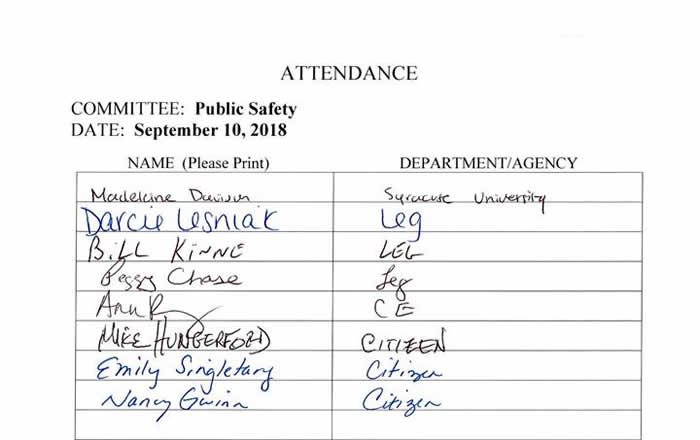
* * *
WAYS AND MEANS COMMITTEE MINUTES
SEPTEMBER 13, 2018
BRIAN MAY, CHAIRMAN
MEMBERS PRESENT: Mr. Ryan, Mr. Knapp, Mrs. Ervin, Mr. Plochocki
MEMBERS ABSENT: Mr. Jordan, Ms. Williams
ALSO PRESENT: Chairman McMahon, Mr. Bush, see also attached list
Chairman May called the meeting to order at 9:13 a.m.
Chairman May referred to the Ways & Means Committee’s 2019 budget review process, which will begin on Friday. He said that a lot has been done to focus on what is coming up on the fiscal matters. It is all based on the premise that program committees—program committee members have developed the expertise and knowledge needed to contribute to the process and allow this to hammer in on the fiscal aspects. He said it will move fast and furious with respect to the departments, but there will be every opportunity to bring them back if needed. There will be plenty of time along the way to do any deep dives. The meetings will start on time, move quickly, so that focus can be on the work product after the meetings are done.
A motion was made by Mr. Knapp, seconded by Mrs. Ervin, to waive the reading of the minutes of the proceedings of the previous committee meeting. MOTION CARRIED. A motion was made by Mr. Knapp, seconded by Mrs. Ervin, to approve the minutes of the proceedings of the previous committee. MOTION CARRIED.
1. ONONDAGA COUNTY CULTURAL RESOURCES TRUST:
a. Confirming Appointment to the Trust for Cultural Resources of the County of Onondaga (Gregg A. Tripoli)
Chairman McMahon noted that he used to serve on the board. Mr. Tripoli is the OHA Director and well known. CRT deals with arts and cultural organizations, especially when there are specific filing applications. They can get bonding that creates a revenue stream for the Trust. The Trust has utilized that revenue to invest back into the arts and culture space. Mr. Tripoli is a good pick.
A motion was made by Mr. Knapp, seconded by Mrs. Ervin, to approve this item. Passed unanimously; MOTION CARRIED.
2. WATER ENVIRONMENT PROTECTION: Tom Rhoads, Commissioner
a. BOND RESOLUTION: A Resolution Approving Proposed Improvements for the Onondaga County Sanitary District Consisting of the Removal of Extraneous Flows from the Meadowbrook-Limestone Wastewater Treatment Plant in and for the County of Onondaga, New York
Mr. Rhoads discussed items 2a and 2b simultaneously:
- Public hearing resolution was authorized last month
- Matter of extraneous flows as Meadowbrook-Limestone Wastewater Treatment Plant
- Have submitted engineering report and grant application to the state, seeking 40% grans funding
- Asking for approval to authorize $9 million project and bonding to abate extraneous flows – causing efficacy of treatment to not meet permit conditions of effluent into the stream
- Majority of aging infrastructure that feeds the plant is owned by 5 local municipalities
- Still work to be done to determine how to provide the remaining funds – portions of county vs local money
- Leadership on the executive level and at the legislature are working on potential alternatives
Mr. Rhoads stated that when the legislature authorized $9 million of work, the county does not actually borrow the money. “We borrow the money as we start to spend it.” This project will take a while to get rolling; normal for grant funding to not be awarded until after the general election. There will time to iron out the allocation of shares amongst the different parties.
Chairman McMahon said that this matter is important because we are under consent and hold the permit. A $9 million problem is known; $9 million satisfies the regulator; the regulator wants the problems satisfied through
I & I projects. Moving forward with legislation today essentially gets the regulator off our backs. The next piece is seeing how the $9 million is paid for if the state grant is received. If received, we will know what the number really is. Chairman McMahon said that he has been talking to some of the partners, and there really is an affordability crisis with some of them as to what they can actually pay. The broader discussion, which he said he is working on, is how we fund our sewers. If this process is done correctly, it might be a model to go forward with the other districts. They are all under pressure and all endanger of some sort of regulatory action from the federal and/or state regulators. He said that we will work very collaboratively with all members of this district – Town of Manlius, Village of Manlius, Village of Fayetteville, Town of Dewitt, and City of Syracuse.
Chairman May said that the timing of the approval of the project is critical. The project has to be funded; hopes there is some success in pulling together a plan that appropriately shares costs where possible and/or creates some equities in other ways where it isn’t. Details of those discussions are probably not appropriate for this meeting, because it not know where it will end up; hope our partners will do their best in whatever comes through.
Mr. Knapp asked if this will be more than a $9 million project in the end. Mr. Rhoads said that he hopes that the Chairman’s report that the State will be happy with $9 million. There is still some regulatory arm twisting. The state has a consent order negotiation process going on. The state is asking for a lot. They have sent a letter to the local municipalities that sets out a number of conditions. The county gas invested over $11 million in treatment plant upgrade there; about $1.3 million in county-owned sewer pipes in this services; granted about $1.6 million in grant funds to these local municipalities. The county’s investment is steep.
Mr. Rhoads said that the regulatory community has an affordability index – look for 1.5% of the annual household income to be applied toward sewer. That is the federal standard. They can be very severe, draconian the way they bring these things back. Consent order negotiations could take a while – it is important to keep our offensive strategy. Doing nothing is when they really assault you with fines, penalties, assessments in consent orders. It is difficult to making investments in infrastructure owned by others, but it also has direct impact on our plant, permit, and by doing this work, there will be less water for us to pump, store and treat, and operations cost will eventually come down.
Chairman McMahon said that it is fair to say that we agree with state regulators regarding the I & I issue – they want to see some additional expenses at our facility that we don’t agree with – we are in a better position to have them see things through our eyes.
Chairman May said that the thing that is really being thrust on us is the timeline. A lot of the work is inevitable, at least for the county-owned portion, but it’s the timeline that hurts – forced to take on debt.
Mr. Ryan reiterated the scenario as presented by Mr. Rhoads. In answer to Mr. Ryan, Mr. Rhoads said that we are all on the same page with this – are strongly encouraging our partners at every level of government – looked for state and federal assistance. The National Association of Clean Water Agencies estimates that there is a trillion dollars of this sort of buried infrastructure problem in the United States. There really isn’t a federal funding scenario for this like there is for transportation, bridges, airports, etc. Mr. Ryan said that the other things are tangible, but we don’t see this underground and don t really understand it.
Mr. Knapp asked if any storm water types are being disconnected when the lines are replaced. Mr. Rhoads said that the county has been doing some work on its Meadowbrook trunk sewer and have so far disconnected 22 illicit storm water connections. A portion of this discussion will also come back to where we are with the county local law from 2011. There are also a number of illicit connections, i.e. sump pumps, which are certainly problematic in many parts of our service areas. Meadowbrook Limestone area is known for its shale soils, which create a lot of wet basements. The approach is to make sure that those private sources of extraneous flow are removed from the sanitary sewer. There is going to be some public education work that the state is expecting. It could be work conducted by code enforcement officers in local municipalities; there are certain things that the local municipalities can do as well, i.e. code enforcement, etc. - would like to see a partnership, stakeholder engagement.
Chairman May said that the scary number, from an exposure or responsibility standpoint, is the fact that almost 99% of the cost of fixing it is technically a responsibly of the other municipalities. It is staggering and of concern.
Mr. Ryan referred to the 22 identified illicit connections, and asked if there is an estimate of that infiltration or the cost – noting that we have stopped one million gallons. Mr. Rhoads said that we work on these estimates and have 13 meters in the system throughout different parts of the system, to help us also accumulate data – required to provide data to the state. He noted that they are done in August, and then there is no rain for a while, so we can’t really measure what happens. It is springtime when ground water tables are high - typically the highest I & I. That is when we can truly measure some of the true recovery or capture. Mr. Ryan asked how many are out there – what is the scope of the problem. Mr. Rhoads said “miles and miles and miles of sewer.” He said that some of it is over 100 years old. Chairman McMahon referred to sump pumps; there are flooding issues in his district and parts of the city – enforcement wise, it will be these localities. Mr. Ryan said that when he was on the Town Board, they were reluctant to do anything about it – they didn’t want to do anything. Mr. Knapp said that nothing his cheap when it comes to any of this. Mr. Rhoads said that it doesn’t get cheaper if we kick the can down the road.
A motion was made by Mr. Plochocki, seconded by Mr. Ryan, to approve this item. Passed unanimously; MOTION CARRIED.
b. BOND RESOLUTION: A Resolution Authorizing the Issuance of $9,000,000 Bonds of the County of Onondaga, New York, to Pay Costs of Improvements for the Onondaga County Sanitary District Consisting of the Removal of Extraneous Flows from the Meadowbrook-Limestone Wastewater Treatment Plant ($9,000,000)
A motion was made by Mr. Plochocki, seconded by Mr. Ryan, to approve this item. Passed unanimously; MOTION CARRIED
3. MANAGEMENT & BUDGET:
a. Monthly Report: Double Encumbered Positions (Res. 86-18)
Mr. Morgan provided the following:
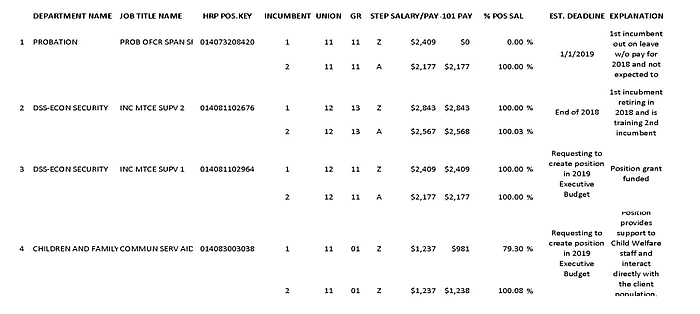
Chairman May said that this is a continuation of work in progress. This report is the obligation. He noted that a memorializing resolution was received from Law Department that details the process. Names are no longer part of the report – we don’t deal with names, we deal with positions and policies. A process is needed for this. The first reaction from the Law Department was the submission of individual resolutions approving each double encumbered position – doesn’t think anyone is interested in that type of process. The main objective is transparency on the issue. There hasn’t been any dialog about the memorializing. He said that if it hasn’t been shared, it will be, but is nothing he would like to take up at this point.
Mr. Morgan said that the report reflects the new positions that have come on since he reported last – 4 new positions. The last two columns were added to the report – estimated deadline and explanation.
Chairman May said that the main purpose of this is to determine a process that is acceptable to everyone; this is tracking towards a process that provides visibility and allows this committee to manage those situations.
4. LAW DEPARTMENT:
a. Litigation Update
A motion was made by Mr. Knapp to enter into executive session to discuss litigation in the matter of Dixie v. Antonacci. Mrs. Ervin seconded the motion. Passed unanimously; MOTION CARRIED.
A motion was made by Mr. Knapp, seconded by Mrs. Ervin, to exit executive session and enter regular session. Passed unanimously; MOTION CARRIED.
Chairman May stated for the record that no action or motions were taken during executive session.
The meeting was adjourned at 10:34 p.m.
Respectfully submitted,

DEBORAH L. MATURO, Clerk
Onondaga County Legislature
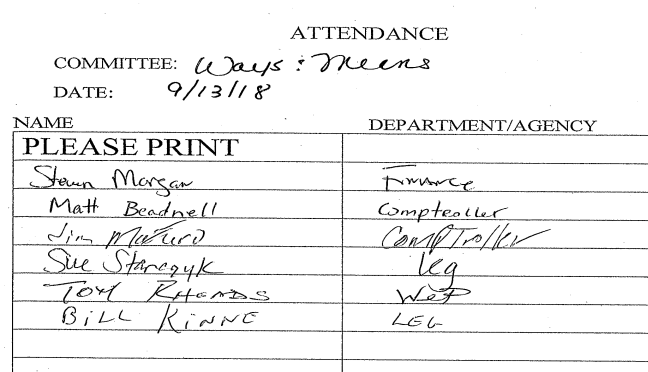
* * *
SPECIAL WAYS & MEANS COMMITTEE MEETING - MINUTES
September 24, 2018
Brian May, Chairman
MEMBERS PRESENT: Mrs. Ervin, Mr. Knapp, Ms. William, Mr. Ryan, Mr. Plochocki, Mr. Jordan
ALSO PRESENT: Chairman McMahon, Mr. Rowley, Mr. Bush, Mr. Holmquist, Ms. Lesniak, Mrs. Stanczyk, Mr. Kinne, Mr. Fisher, Mr. Beadnell, Mr. Maturo, Mr. Durr, Mr. Morgan, Mrs. Berger
Chairman May called the meeting to order at 2:00 p.m.
1. TRANSPORTATION: Marty Voss, Commissioner
a. Regarding Snow Plow Services Provided by the County and Local Governments Within the County - Amending the 2018 County Budget to Accept Additional Revenue from New York State, Making Funds Available for Use, and Authorizing the Execution of Agreements
-
Every year the state assesses the winter and issues a severity factor
-
If severity factor is above the number one, there is an allocation to municipalities that do plowing for the State
-
County plows approx. 190 miles for the state
-
5-year contract with towns and village – plow about 250 miles of county roads
-
When county gets the severity factor from NYS, by statute and legislation, we pass those dollars on to the towns and villages that plow for us
-
Severity factor was 2.17 this year, 217% of what a normal winter would be--seemed high, so Mr. Donnelly got involved, and it was determined to be accurate
-
Then questioned the prior two years when it was 0% - went back to the State and figured out that they shorted us
-
Through summer and fall, have been able to work it out with the State – legislation today will pass along those dollars to towns and villages that plow for us
-
Small allocation for Cayuga County for strip of road in Spafford that they plow
-
Will get payments out to towns and villages by the end of the year
Mr. Knapp thanked Mr. Voss and Mr. Donnelly for this year and for also going back two years and appealing our case basically. It amounts to a lot for our towns and villages. Mr. Voss said that there was a lot of help from the Management & Budget staff. Mr. Knapp said that a lot of the towns are doing their budgets right now, and this is a windfall for them to buy equipment, salt, and sand for next year on this year’s money – wanted to get the funds out to them as quickly as possible. The towns can’t count this money in their budget until the legislature approves it.
Chairman May said that it’s a great benefit to the towns and it was great work by everybody involved who found the money and structured the deal to begin with.
A motion was made by Mr. Knapp, seconded by Mr. Jordan, to approve this item. Passed unanimously; MOTION CARRIED.
2. NBT BANK STADIUM: Ryan McMahon, Chairman; William Fisher, Deputy County Executive
a. Bond Resolution: A Resolution Authorizing the Issuance of Bonds at the Maximum Amount of $8,500,000, in and for the County of Onondaga, New York, to Pay Costs of Constructing and Reconstructing Improvements at the NBT Bank Stadium ($8,500,000)
b. A Local Law Authorizing a Lease Agreement for the Use of NBT Bank Stadium
c. Making Funds Available for use in Connection with Maintenance, Repairs, and Replacements at the NBT Bank Stadium
Chairman McMahon:
- Have been briefed on relationship with Mets for some time
- Mets recently bought Syracuse Chiefs Baseball Team for $19 million; they made a significant investment in our community
- They recognize that NBT Stadium has some good bones; it’s not the way you would build a modern-day minor league baseball stadium
- It’s too big (seats); amenities that help drive fan experience and attendance aren’t really there
- Have been discussions to keep the Mets here for an extended period of time and in AAA baseball – important for the quality of product we are putting on the field for our residents, there would need to be a commitment from the county for some improvements – similar to what was done with the War Memorial with the Crunch
- Discussions have been ongoing – negotiating with a major league baseball team, who owns the minor league team, and at the same time trying to draw all of the sources of funds in, is a complicated process
- Getting close – asked Mr. Fisher to come here and answer additional questions – if all of this can get ironed out, we have the ability to act on it at some point in October
- With the new lease I wanted a 25-year commitment from the NY Mets to Syracuse
- Looked at the lease and made tweaks that are good for both sides; Mr. Fisher has worked extensively with the law dept. on that
- In exchange for the commitment, we put together a package a $8.5M bond locally – similar to bond request for the War Memorial; pledge naming rights for term of the lease
- Some of the naming rights revenue would come from both county and NY Mets – moved into a project account – we would front that cash
- Look for other potential in-kind sources, and ask the state for a match – getting close, but don’t have the final green light on that
- Overall, if we got these sources of funds, and we get the match, that would give us a $25 million type project to make important investments in the stadium that are good for us and good for the Mets – so that we then get more attendance and have a successful organization here
Mr. Fisher:
-
Have been working with the Mets and with NYS
-
P&C Stadium construction was accomplished with a 50% state match – originally a $32 million project with essentially $16 million cash from NYS
-
NYS allowed $3 million of in-kind work that the county DOT or sanitation and sewer dept. was credited with; the other $13M came from the Toronto Blue Jays for $1M; County Legislature pledged naming rights of $3.75M, a $3M bond; county took 1st 15 years of rent from Syracuse Chiefs
-
Predecessors found a variety of sources that NYS was willing to match
-
Working with NYS to make sure they are willing to do that again; when complete there will be an agreement between the county, state, and NY Mets
-
Lease draft came back on Friday afternoon committing to a 25-year lease – current lease has 7 years left through 2025 and extending it by another 18 years
-
Mets agreed verbally that it would be a AAA team
-
Mets agreed to several other things:
-
County took over utilities a couple of years ago and will continue to pay for them
-
County also took over the first $75K of stadium costs for care of the field – we asked that after the current lease expires in 2025 that the Mets revert to paying for all of those costs – Mets have agreed to that
-
County has asked for rent increases to begin after 2025 which Mets have agreed to (in 2026 rent will increase from $220K to $225K in place for a number of years; goes to $250K, then $275K, and then $300K).
-
Mets asked that the County commit to a bump in how much of the rent goes back into the facility – right now $25K of the rent each year is dedicated to the stadium infrastructure fund – Mets have asked that it be calculated at 15% of the rent
-
Not a lot of changes in the lease – have agreed to go with the lease in existence
-
Will bring the legislature a red-lined version – in order to vote on it, there would have to be an authorization for the county executive to sign
-
Did not have the lease in final form last Friday; goal is to place the lease and local law on legislators’ desks enter the county executive to enter into the lease
-
Price of project--working with EwingCole Architects and NYS as to what goes into the project – a budget of above $25 million
-
Asking for bond of $8.5M – in draft – anticipate a final bond resolution later this week
-
A bond resolution appropriating $3.6M in future naming rights
-
Current naming rights agreement with NBT Bank – last payment is due October 1, 2024 – would cover baseball season in 2025
-
There is 18 more years in which a stadium lease agreement could be obtained; agreement with the Mets that they will be involved in selling that naming rights program
-
Know from Live Nation that when you have people that sell these nationally that have a strong sales organization, i.e. Citi Field has lots of sponsors, having access to their customer list will be very beneficial
-
After 2025 lease will call for splitting naming rights 50% with Mets; Mets have agreed to take their share of the naming rights and put it back into the project; if any additional naming rights revenue above the $200K, Mets will put that back into the stadium infrastructure fund
Chairman May said that there are 3 items before the committee; there won’t be any action on any of them – today is informational.
Mr. Jordan asked what options or abilities are there in the proposed lease for either the county or the Mets to opt out of the agreement. Mr. Fisher said that he doesn’t think there is a termination without cause clause. If the Mets leave without cause there is a non-relocation clause that would require them to pay back all of the funding that came in from the state or the county. There is also an accelerated rent clause. They have been in New York since 1961, are confident that they will be here for another 25 years; are giving strong guarantees. Mr. Jordan asked that that committee be provided with copies of the proposed lease.
Mr. Knapp asked what the breakdown is: $8.5M bonding from the county; $3.6M from naming rights and future naming rights; New York State piece is matching our piece, $8.5M - all together that is a little over $20 million. We are are talking about a $27M - $28M project – where is the other $7 or $8M coming from. Mr. Fisher clarified that the proposal is that the state is matching the naming rights portion also. He explained that there are a couple of other funding sources that involve in-kind services from the county or other municipalities.
Chairman May referred to the $3.6M for naming rights and asked if it will be a cash flow situation. Mr. Fisher said it would be done like it was originally. The county legislature had authorized $3.75M to be put into the stadium; then a deal was cut with P&C and then replaced by NBT Bank. As the money comes in, it goes into the project account where the money was spent out of in the first place.
Chairman May said that it is unique process to determine/identify what the market has to bear. In the case of the amphitheater, we didn’t have a formal process per se, but it was broadly known that the county was seeking applicants to name the facility. He asked what is envisioned for the process for NBT Stadium. Mr. Fisher said that an existing naming rights agreement with NBT Bank, originally signed with Alliance Bank, a 20-yr. agreement for $2.8M. That agreement was assigned by Alliance Bank to NBT Bank when NBT acquired Alliance. The agreement has a right of first refusal written into it. We are going to comply with the contract and negotiate first with NBT Bank. There have been conversations with the regional bank management, who is very interested in discussing this; they have a naming rights agreement that expires after the 2025 baseball season. They are not feeling any urgency in extending that right now, but are aware that they have a right of first refusal. They are interested, when the time come, to enter into negotiations with the Mets and County about extending that agreement. He said that he would have to check with law department as to whether the approval the legislature had given with the stadium being named NBT Bank would continue in an extension. That would be the easiest path, and an agreement with the Mets providing an additional sponsorship program benefits on top of that. If that fails, we would have to have a process where the Mets and the County advertise that the naming rights are coming back onto the marketplace. Chairman May said that we won’t see any revenue against the $3.6M until the current agreement expires; Mr. Fisher agreed. Mr. Jordan said that in the meantime, we would still be getting that revenue. Mr. Fisher agreed, noting that NBT pays $150K each year, but it goes into a project that is in the red. It goes into the black in 2023. There is $246K left in that project. If it were pledged toward the project, if the state is willing to match that, then the payment in 2024 and a little in 2023 would be a source of matching funds.
Chairman May asked why the $3.6M isn’t part of the bond. Mr. Fisher said it could be, if you want to increase the amount being borrowed. If the credit markets change, then it would be prudent to borrow, or if we needed the money because of cash flow problems.
Chairman McMahon said that there was a similar model with the War Memorial. With the Mets, there is a unique situation with our affiliated partner; they own their minor league teams in their system. They get sponsorships; one of their sponsorships in Port St. Lucy is a business that doesn’t even do a lot of business in Florida, but are doing business with the Mets. Their buying power is pretty significant. That is one of the ways that this model makes sense – looking as sponsors. He said that he has confirmed that there is no debt on the books at the old ball park.
Mr. Knapp asked for clarification about the bonds for the original construction at the stadium being done; Chairman McMahon said that they are paid off. Mr. Fisher said that the replacement of the turf with grass bond has been paid off.
Mr. Rowley asked if the naming rights piece of this proposal is subject to procurement laws; questioned why we are limiting ourselves to $3.6 million. There could be a bigger market out there if we go to bid or do something public, notwithstanding the right of refusal clause that we have now. Mr. Fisher said that we are not limiting it to that amount; we could appropriate $4 million. With the Amphitheater going with $300K per year on average and getting $151K on the stadium, we thought it was prudent to say $200K – can make the number easily. The Mets side of it would come back into the stadium infrastructure fund. The county side of the surplus would have to be appropriated. Mr. Rowley questioned that a public process is not anticipated for the naming rights piece. Mr. Fisher said that we have contract with NBT Bank Stadium that is enforceable by NBT Bank; thinks we would be violating a contract.
The meeting was adjourned at 2:41 p.m.
Respectfully submitted,

DEBORAH L. MATURO, Clerk
Onondaga County Legislature
|

























